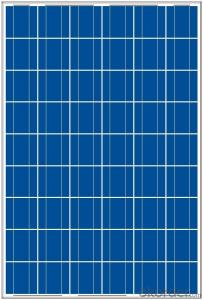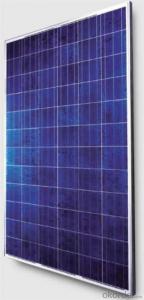Crystalline Solar Panels for 10kw Rooftop Systems
- Loading Port:
- Tianjin
- Payment Terms:
- TT OR LC
- Min Order Qty:
- 78000 watt
- Supply Capability:
- 10000000 watt/month
OKorder Service Pledge
OKorder Financial Service
You Might Also Like
Crystalline Solar Panels for 10kw Rooftop Systems
Solar modules use light energy (photons) from the sun to generate electricity through the photovoltaic effect. The majority of modules use wafer-based crystalline silicon cells or thin-film cells based on cadmium telluride or silicon. The structural (load carrying) member of a module can either be the top layer or the back layer. Cells must also be protected from mechanical damage and moisture.
Bypass diodes may be incorporated or used externally, in case of partial module shading, to maximize the output of module sections still illuminated.
Some recent solar module designs include concentrators in which light is focused by lenses or mirrors onto an array of smaller cells. This enables the use of cells with a high cost per unit area (such as gallium arsenide) in a cost-effective way.
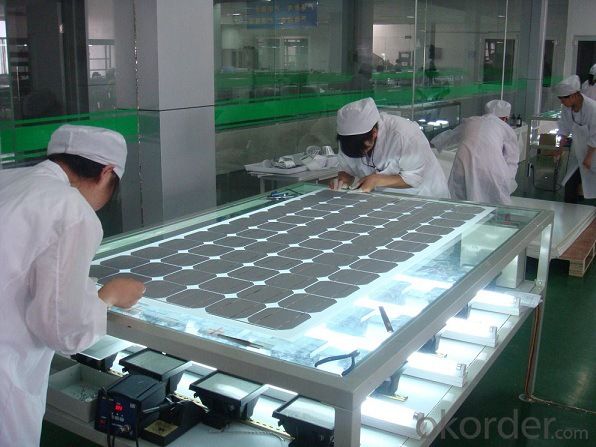
Specifications:
solar panels from 5W--300W, made of TAIWAN MOTECH brand cells,with CO in TAIWAN,Mono and Poly with VDE,IEC,CSA,UL,CE,ISO.
We import solar cells from Taiwan Motech brand, with this CO in taiwan and our CSA certification,we can still sell goods to Anti-dumping areas like USA. Our main products are solar panels, off grid and on grid solar home systems , solar street lighting systems, solar water heating system,solar pump,solar attic fan, solar DC LED lights and solar DC refrigerators.
Certificates : ISO, CE, VDE IEC, MCS, CSA-UL, CEC.
Delivery time: sample 10days, order 25-30days.
Sample: charged.
Payment term: T/T 30% as deposit, 70% before shipment. Or irrevocable L/C at sight.
Trade term: FOB Shenzhen or CIF destination seaport or Airport.
Characteristics:
I.Solar Cell : High efficiency crystalline solar cell. Even if under the weak light, the solar module can produce maximum power output.
II.Tempered glass (toughened glass): Anti-reflecting coating and high transmission rate glass increase the power output and mechanical strength of solar module.
III.EVA and TPT: Using high quality EVA and TPT to prevent destroying and water.
IV.AI frame: Without screw, corner connection. 6 holes on the frame can be installed easily.
V.Junction box: Multi function junction box with water proof.
VI.Long lifetime: ≥25 years; Less power decrease.
VII.Good performance of preventing from atrocious weather such as wind and hails.
VIII.Resisting moisture and etching effectively, not effected by geology.
IX.The certificate issued by international authority: UL, TUV, IEC, VDE, CE.
Quality and Safety
1. Rigorous quality control meets the highest international standards.
2. High-transmissivity low-iron tempered glass, strong aluminium frame.
3. Using UV-resistant silicon.
4. IS09001/14001/CE/TUV/UL
Warranties
1. 10 years limited product warranty
2. 15 years at 90% of the minimal rated power output
3. 25 years at 80% of the minimal rated power output
Technical date :
ITEM NO.: | Poly 156*156 cell ,60pcs . Power range from 230Wp-260Wp | ||||||
Maximum Power(W) | 230 | 235 | 240 | 245 | 250 | 255 | 260 |
Optimum Power Voltage(Vmp) | 29.4 | 29.5 | 29.7 | 30.1 | 30.3 | 30.5 | 30.7 |
Optimum Operatige Current(Imp) | 7.83 | 7.97 | 8.08 | 8.14 | 8.25 | 8.37 | 8.48 |
Open Circuit Voltage(Voc) | 36.7 | 36.8 | 36.9 | 37.1 | 37.3 | 37.5 | 37.7 |
Short Circuit Current(Isc) | 8.52 | 8.59 | 8.62 | 8.65 | 8.69 | 8.73 | 8.78 |
Solar Cell: | 156*156 Poly | ||||||
Number of Cell(pcs) | 6*10 | ||||||
Name of Solar Cells | Polycrystalline Cell | ||||||
Size of Module(mm) | 1650*992*40/45/50 | ||||||
Cable & Connector Type | Pass the TUV Certificate | ||||||
Frame(Material Corners,etc.) | Aluminium-alloy | ||||||
Back sheet | TPT | ||||||
Weight Per Piece(KG) | 19.5KG | ||||||
FF (%) | 70-76% | ||||||
Junction Box Type | Pass the TUV Certificate | ||||||
Tolerance Wattage(e.g.+/-5%) | ±3%, or 0-3% | ||||||
Front Glass Thickness(mm) | 3.2 | ||||||
Temperature Coefficients of Isc(%) | +0.04 | ||||||
Temperature Coefficients of Voc(%) | -0.38 | ||||||
Temperature Coefficients of Pm(%) | -0.47 | ||||||
Temperature Coefficients of Im(%) | +0.04 | ||||||
Temperature Coefficients of Vm(%) | -0.38 | ||||||
Temperature Range | -40°C to +85°C | ||||||
Surface Maximum Load Capacity | 5400Pa | ||||||
Allowable Hail Load | 23m/s ,7.53g | ||||||
Bypass Diode Rating(A) | 12 | ||||||
Warranty | 90% of 10 years, 80% of 25 years. | ||||||
Standard Test Conditions | AM1.5 1000W/ 25 +/-2°C | ||||||
Packing | carton or pallet | ||||||
1*20' | 14 Pallets / 316pcs | ||||||
1*40'STD | 25 Pallets / 700pcs | ||||||
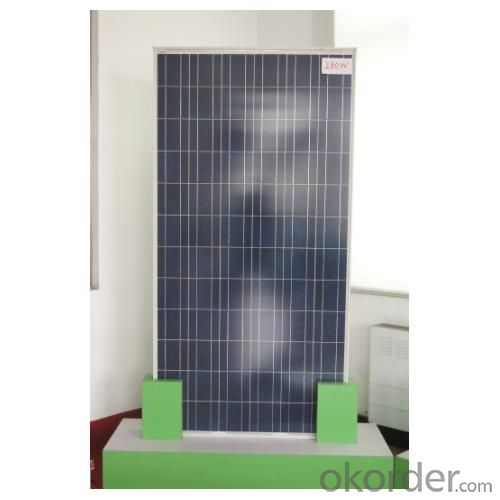

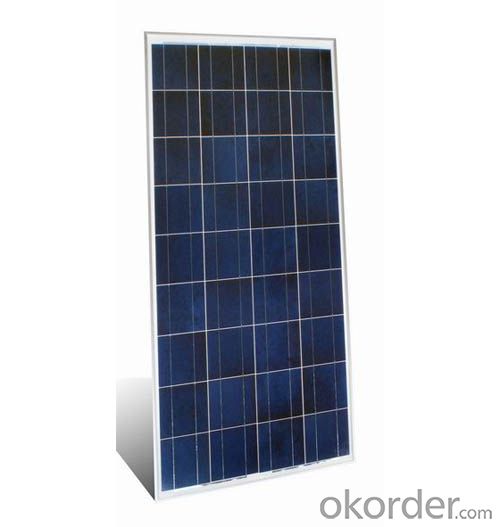
FAQ:
I..Will you focus on the safety of the goods during transportation?
Yes, Safety of the cargo is the primary element that we would consider on transportation.
II..How would guarantee the quality will meet the requirements of your clients?
Before shipment, we will have inspection for each batch of goods.
III..What certificates do you have?
IEC,UL,TUV,CSA,etc.
IV..Can you do OEM according to clients’ requirements?
Yes, we have our own brand while we can provide OEM service.
- Q:i need someone to advice me which solar panels to buy.i have looked into few companies and i need some more info before decidingthe companies i checked were Sun tech trina solar Canadian solar and LDK solar.whice company should i pick?? please help.
- I did that 25 years in the past and happy I did. they're nonetheless operating high quality with little upkeep. we stay in necessary large apple so we've about an same type of cloud cover you do, and at the same time as that is no longer suitable, you could make it artwork. the nice and comfy button isn't spending plenty so that you've a life like payback time. I designed and outfitted my own, yet i did not layout for top performance; and at the same time as it would not generate all our warm water each and each of the time, it takes the edge off our gas bill. locate someone who has them and note if it paid off for them. don't be the first to get them until eventually you opt for to do slightly engineering. image voltaic voltaic panels could no longer be used to warmth water electrically, that is truly inefficient and could no longer payback. DHW heating is low-tech and all and dissimilar needs warm water. Voltaics receives extra valuable in years yet to go back, and expenditures are dropping so it would not make experience to purchase now.
- Q:Does anybody know if there are any courses for solar panel installation, and/or what trades you need for this position?
- What you ought to recognize will depend on WHAT sort of installations you're going to be operating with. In regular, for business you wish to have fundamental mechanics and wiring. For house, you may additionally want a few carpentry, roofing, preserving structural integrity, plumbing, and so on. In side it additionally will depend on what sort of sun installations you're doing, (vigour, air warmers, water warmers, and so on.)
- Q:Can solar panels be used in agriculture?
- Yes, solar panels can be used in agriculture. They can provide clean and renewable energy to power various agricultural processes such as irrigation systems, livestock operations, and crop drying. Additionally, solar panels can be installed on farm buildings or in open fields, helping farmers reduce their reliance on traditional energy sources and lower their carbon footprint.
- Q:Can solar panels be installed on a historical building?
- Yes, solar panels can be installed on a historical building. However, the installation process should be carefully planned and designed to minimize any potential impact on the building's historical integrity. It is important to consult with experts and adhere to any local regulations or preservation guidelines to ensure a harmonious integration of solar panels without compromising the building's historical value.
- Q:Do solar panels work with any type of heat or only sunlight? I have a bunch of little ideas floating around in my head and Id like to get them on paper but only if they really would work.Also does a concentrated amount of heat on one solar panel piece (quot;xor so) produce a higher or equal amount of electricity than a less concentration over a larger area?
- Solar photovoltaics require light, any kind of light. A torch would work, for example. The effect of concentration depends on the amount of light and the material you're shining it on. In CdTe, warmer temperatures and more intense light may lead to better performance. In silicon I think the opposite is true (I don't know though, I've only done research work with CdTe). It depends on properties of the semiconductor, like its band structure. To get an 'order of magnitude' estimate, you may assume a constant efficiency of solar cell so total amount of light (= area * intensity) largely determines the output in standard operating conditions.
- Q:How do solar panels affect the overall carbon footprint of a building?
- Solar panels can significantly reduce the overall carbon footprint of a building. By harnessing the power of the sun to generate electricity, solar panels reduce the reliance on fossil fuels for energy production. This means that less greenhouse gases, such as carbon dioxide, are released into the atmosphere during the building's operation. Consequently, solar panels contribute to a cleaner and more sustainable energy system, helping to mitigate climate change and reduce the building's environmental impact.
- Q:I would like to connect a solar panel to a small fan. I am not sure as to what is needed to actually quot;connectthe two together. Any help is appreciated.
- Solar panel hooked to a battery or two then to a small inverter then to your 20 volt fan ....... Or .... Solar panel to 2 volt battery wired to a 2 volt fan. I use both
- Q:What is the difference between on-grid and off-grid solar systems?
- The main difference between on-grid and off-grid solar systems lies in their connection to the traditional electrical grid. On-grid solar systems are connected to the grid, allowing them to both generate and consume electricity from the grid when needed. They can also feed excess electricity back into the grid, earning credits or compensation through net metering. In contrast, off-grid solar systems are not connected to the grid and operate independently, relying solely on solar energy to generate and store electricity in batteries for use when the sun is not shining. Off-grid systems are typically used in remote areas where grid connection is not available or for those seeking complete energy independence.
- Q:How do solar panels affect the electrical grid?
- Solar panels can have both positive and negative impacts on the electrical grid. On the positive side, solar panels help to reduce the demand for electricity from the grid, especially during peak hours when electricity is most expensive. This can lead to cost savings for the grid and reduce the need for additional power plants. Additionally, solar panels generate clean, renewable energy, which helps to reduce greenhouse gas emissions and combat climate change. However, the intermittent nature of solar power can pose challenges to grid stability and reliability. Fluctuations in solar energy production can create imbalances in supply and demand, requiring grid operators to carefully manage and integrate solar power into the system. Overall, solar panels can be a valuable addition to the electrical grid, but their integration requires careful planning and management.
- Q:My husband is interested in buying solar panels for the roof and i dont know where to find them.
- I co own Sunpower Solutions. We are a solar company in South Jersey. I can tell you that the average cost for a system under 7Kw, is $7.95 per watt. What people fail to realize, is that there is a lot more that goes into a PV system than just panels. Racking, hardware, combiner box, inverters, labor to put the panels up, pay the electrician that ties it all together, the architect that measures the wind load on the panels, etc. It's not cheap. Although, in the state of NJ, the the amount of time it takes for the system paying for itself, is 4 years. It doesn't matter if it's a huge system or the smallest PV system, it's 4 years. Any questions, just ask. @Martin: The thing with those programs, is that the company that is leasing the system, is taking advantage of the renewable energy credit that the system is producing. Yes you get cheap electricity, but you are not taking advantage of the money making ability of the renewable energy credits.
1. Manufacturer Overview |
|
|---|---|
| Location | |
| Year Established | |
| Annual Output Value | |
| Main Markets | |
| Company Certifications | |
2. Manufacturer Certificates |
|
|---|---|
| a) Certification Name | |
| Range | |
| Reference | |
| Validity Period | |
3. Manufacturer Capability |
|
|---|---|
| a)Trade Capacity | |
| Nearest Port | |
| Export Percentage | |
| No.of Employees in Trade Department | |
| Language Spoken: | |
| b)Factory Information | |
| Factory Size: | |
| No. of Production Lines | |
| Contract Manufacturing | |
| Product Price Range | |
Send your message to us
Crystalline Solar Panels for 10kw Rooftop Systems
- Loading Port:
- Tianjin
- Payment Terms:
- TT OR LC
- Min Order Qty:
- 78000 watt
- Supply Capability:
- 10000000 watt/month
OKorder Service Pledge
OKorder Financial Service
Similar products
New products
Hot products
Hot Searches
Related keywords
